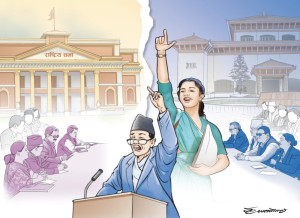Columns
Codifying the breaking of wind
The Nepali state’s desire to control all aspects of life, including our orifices, is omnipresent.
Amish Raj Mulmi
Nepal has had a history of some terrible laws. A few recent examples include the Ratnanagar Municipality’s decision to not allow women with children under the age of two to fly abroad, or the much-derided national law that women under 40 must seek consent from both their families and their local ward office to travel abroad. The inspiration for such laws is obvious. There is an inherent desire in the Nepali state to control our bodies. In a patriarchal society like ours, laws like these are defended by stating they intend to reduce human trafficking of Nepali women. But the intent remains clear: it is the state that will decide what its citizens can or cannot do.
The Nepali state has also had a history of codifying and legalising caste and gender hierarchies that have allowed them to perpetuate in society (rather than eliminating them). Jung Bahadur’s 1854 Muluki Ain, for example, encoded caste hierarchies by dividing Nepali society into different status groups. The first complete English translation of the Muluki Ain was recently brought out by scholars associated with the University of Heidelberg, and on social media, I came across another law that seems ludicrous at first, but in fact says a lot about how the state has traditionally viewed Nepali citizens.
The law was about breaking wind, or farting. As was usual in Jung Bahadur’s civil code, there are different standards for breaking wind for different castes. If someone farted ‘in the face’ (why so specific, one could ask?) of another of the same caste or lower, he would be fined Rs5. But that’s not enough. The victim, too, could be expiated—or make amends—by paying a fee of 4 annas. For a tagadhari, including the ‘Rajputs’, the fine for flatulence in an equal or higher caste’s face was Rs7.5, but if a non-enslavable matwali, or alcohol-drinking caste, did so in the face of a tagadhari, or the janai-wearing castes, the fine rose to Rs10, and the fees for expiation rose to 8 annas. The fine rose to Rs15 for an enslavable matwali caste, but if the latter broke wind in the face of a non-enslavable matwali, they could get away by paying Rs5. However, for the untouchable or the paani nachalne jaats, breaking wind in the face of a higher paani chalne jaats would cost them Rs20, and the fees for expiation also rose substantially to Rs1.5.
As with most laws, the untouchables would have been hit the hardest. Rs20 would have been a significant sum over a century and a half ago. And, by virtue of the untouchable castes being at the lowest rung of the economic and social ladder, such a fine would have created severe economic strain, and even social backlash. The Muluki Ain was said to codify what had been practiced in scriptures, state policy and existing customs, but the inspiration from the Manusmriti is obvious. While the Ain is also significant in that it was the first civil and religious code that was enforced across Nepal, reading it from a contemporary perspective also informs us about the foundations of the Nepali state itself.
For example, consider the idea of expiation, which comes from the Hindu notion of prayaschit and basically means that if a caste person committed a sin or did something that could besmirch their status, they could pay a fine and get away with it. As historian John Whelpton has written, a dharmadhikara, or religious morals judge, was usually appointed from families that gave rajgurus; they would be responsible for the fine, and in turn grant a certificate known as patiya.
The Muluki Ain is littered with instances where expiation is possible. Beyond the above-quoted instances, one particular law that has stayed with me is regarding the death of a cow. If a cow or an ox was killed by a tiger or a wild animal, or by lightning or fire, or because of a disease or sudden reasons, or even if it was strangled by its own halter, the cow owner could pay a fine of 2 annas to the court to be expiated of his sin.
Cow slaughter was obviously one of the greatest sins a caste Hindu could commit, but the idea that one could get away unblemished of the sin by paying a fine is a curious position for the state to take. Such a formulation suggests the Nepali state desired to raise revenue from every means possible.
Today, the business community would argue the state thinks along similar lines. Even before the current lockdown had ended, several businesspersons had told me that vehicular movement would resume in the month of Asar, so that the government could collect taxes. Their predictions came true, and the government began to press the private sector to pay up as soon as the Supreme Court rescinded its earlier stay on the collection of value-added tax.
Jung Bahadur’s Muluki Ain reads like an anachronistic piece of legislation today, but the codified hierarchies, obsession with women’s bodies and sexuality, and ludicrous laws on breaking wind and spitting also tell us about the values the Nepali state has been founded upon. The desire to control the citizenry’s worldview, morality and private spaces has never seemed to go away. Hierarchies continue to be codified through unequal citizenship laws and other exclusionary practices limiting women and marginalised groups. And citizens continue to be viewed as a revenue source, despite the pandemic.




 16.2°C Kathmandu
16.2°C Kathmandu















